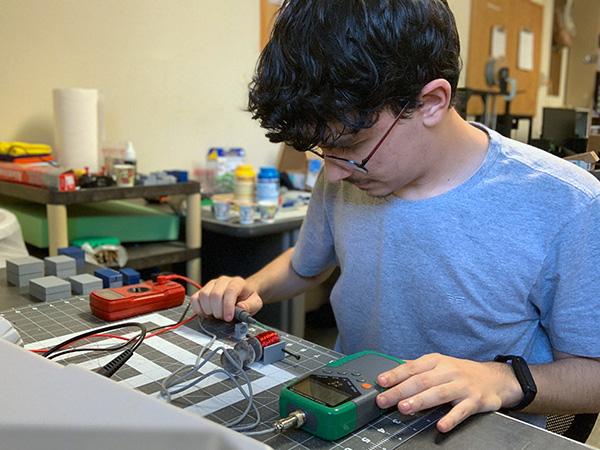Designing Materials for Flexible Robots
Project Title
Design and Fabrication of Soft Robotic Linear Actuators using Dragon Skin™ and Iron Powder
Faculty Mentor(s)
Project Description

Imagine a future with robots that don’t have any metallic or rigid parts – everything is flexible and even huggable. Our research delves into the realm of soft robotics, where we explored a simple yet useful material combination: silicone and iron powder. Through different prototypes, we have demonstrated the potential of this mixture for muscle-like devices.
Soft robotics, a subfield of robotics that employs flexible materials and devices for adaptable and safer human interactions. We previously found that combining silicone (DragonSkin™) and iron powder creates magnetically capable and flexible materials, but their application in soft robotics remains uncertain. This research explores possible designs of muscle-like actuators using permanent neodymium magnets and solenoids, involving over five versions and different iterations. The manufacturing process is shown to be promising, potentially leading to affordable prototypes.
Why is your research important?
This research is important because it addresses a combination of materials that hasn’t been discussed in the literature, which can be one of the most cost-effective alternatives to create soft devices. Moreover, this work can be applied to prosthetics and automation applications.
What does the process of doing your research look like?
It begins with an idea, followed by designing a CAD model on SolidWorks, 3D printing it, which is then filled with prepared silicone material. After allowing the silicone to cure, the final design is removed from the mold. Subsequently, thorough analysis is conducted to identify any issues and to ensure that the actuator functions as intended.
What knowledge has your research contributed to your field?
We made great contributions to the field by confirming that the silicone and iron powder combination exhibits flexibility as good as standard silicone, making it a promising option for soft robotics devices. Our work showed optimistic results for contraction mechanisms with permanent magnets and the development of a solenoid.
In what ways have you showcased your research thus far?
I have presented the initial experiments conducted over the Winter at the College Research Symposium.
How did you get involved in research? What drove you to seek out research experiences in college?
As a STRONG scholar, I was paired with Prof. Patrick Simen to do the Winter Term research since we shared similar interests, such as robotics and 3D printing. I have a deep passion for investigating and prototyping, so I was really excited to be part of this research. In High School, I managed groups and projects that focused on low-cost devices and robots for competitions, and I wanted to continue developing similar skills in college.
What is your favorite aspect of the research process?
Everything that requires a combination of creativity and testing excites me. In that sense, being able to have my own ideas transformed into reality with a 3D printer is incredibly rewarding. Moreover, the fact that I need to consider different physical formulas and try to use them to make a useful mechanism is stimulating.
How has working with your mentor impacted the development of your research project? How has it impacted you as a researcher?
Prof. Simen has been an indispensable mentor for this research. He has experience in both silicone molding and 3D printing and has helped me with countless of issues as well as useful proposals for designs. He made me realize the importance of persisting when I face setbacks since it’s mainly a trial-and-error research project.
How has the research you’ve conducted contributed to your professional or academic development?
As an aspiring engineer, this work has provided hands-on experience with 3D printing (manufacturing and troubleshooting) and gave me more confidence with CAD design. Being introduced to materials science also offered me a possible path I can follow in terms of research.
What advice would you give to a younger student wanting to get involved in research in your field?
To get involved in robotics or engineering research, begin with small projects to learn a good foundation of skills and fixing broken things. Practical experience fosters a deeper understanding of both fields. Not to mention, studying physics behind how devices work gives you new ideas of how people develop the tools we use.
Students

Otávio Paz Nascimento ’26
second-year- Major(s): Physics, Computer Science